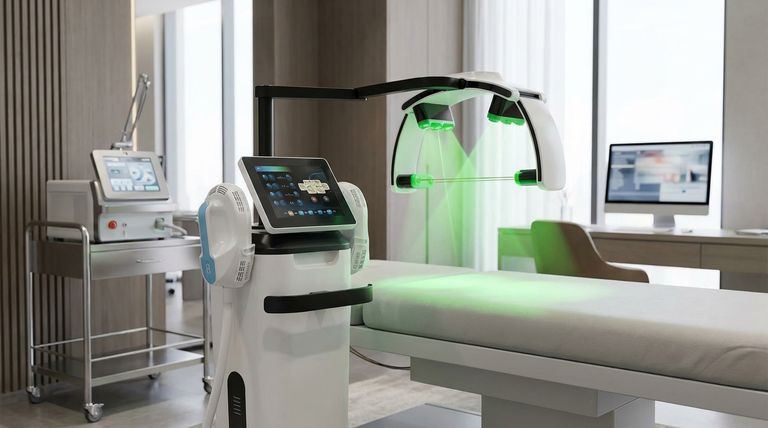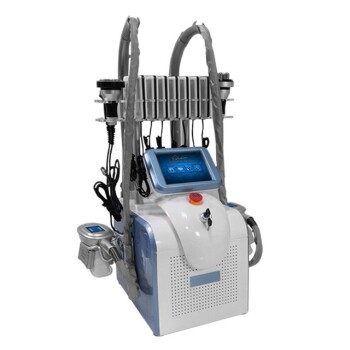In short, no. The term "laser lipo" is used to describe a wide and often confusing array of machines that operate on fundamentally different principles. These differences in technology directly translate to vast differences in the procedure's mechanism, invasiveness, recovery time, and, most importantly, its results.
The critical distinction is not the brand name, but the underlying technology—specifically, whether the machine is minimally invasive (destroying fat cells from within) or completely non-invasive (stimulating fat release from the surface). This single factor determines the procedure's efficacy and what you can expect from the treatment.

The Fundamental Divide: Invasive vs. Non-Invasive
The most significant difference between "laser lipo" machines is how they deliver energy to the fat cells. This splits the technology into two distinct categories.
Minimally Invasive Laser Lipolysis
This is the original and more technically accurate form of "laser lipo." It is a surgical procedure performed by a medical professional, often under local anesthesia.
A very thin fiber-optic cable is inserted through a tiny incision in the skin. This fiber delivers concentrated laser energy directly into the subcutaneous fat layer. The intense heat melts and destroys the fat cells—a process called lipolysis. The liquefied fat is then gently suctioned out.
Because this method physically removes the fat cells, the results are considered permanent. The heat generated also has a secondary benefit of stimulating collagen production, which can lead to skin tightening in the treated area.
Non-Invasive Laser Therapy
This category is often called "cold laser" or "low-level laser therapy" (LLLT). It is a completely external procedure with no needles, incisions, or downtime.
Paddles or applicators are placed directly on the surface of the skin over the target area. These devices emit low-level laser energy that penetrates the skin and is absorbed by the fat cells.
Instead of destroying the cells with heat, this light is believed to stimulate the cell membrane, creating temporary pores. This causes the fat cells to release their contents (triglycerides) into the space between cells. The body’s lymphatic system is then responsible for collecting and processing this released fat.
The fat cells themselves are not destroyed, merely emptied. This means results are temporary and heavily dependent on a patient's ability to maintain a healthy diet and exercise regimen to burn off the released fat.
Key Technical Differentiators That Matter
Beyond the core invasive/non-invasive distinction, several technical specifications further separate these machines and their effectiveness.
Wavelength Determines the Target
Different wavelengths of laser light are absorbed by different components in the body.
A 1060nm diode laser, for example, is highly absorbed by adipose (fat) tissue. This makes it effective for heating and destroying fat cells from outside the body in a non-invasive thermal treatment.
In contrast, a 635nm red light laser does not generate significant heat. Its purpose is not destruction but biostimulation—triggering the fat cell to open its temporary pores, as seen in LLLT devices.
Thermal vs. Athermal (Hot vs. Cold)
This ties directly to wavelength. Thermal lasers use heat to induce apoptosis (controlled cell death) in fat cells. This applies to both minimally invasive procedures and some non-invasive ones that heat the skin's surface.
Athermal ("cold") lasers use light energy without a significant thermal effect. Their goal is to create a temporary biological response in the cell, not to destroy it.
Combination Technologies
Many modern platforms are not just lasers. They often combine technologies to improve results. A machine might integrate a laser for fat reduction with radiofrequency (RF) for enhanced skin tightening or use a vacuum and massage function to aid lymphatic drainage and help clear the released fat more efficiently.
Understanding the Trade-offs
Choosing a technology requires balancing expectations, cost, and tolerance for downtime.
Efficacy vs. Downtime
Minimally invasive laser lipolysis offers more dramatic and permanent results, often in a single session. However, it requires a medical procedure with local anesthesia, potential bruising, swelling, and a few days of recovery.
Non-invasive laser therapy has zero downtime. You can return to normal activities immediately. However, results are more subtle, require a series of multiple treatments, and are not permanent.
Operator Skill Matters Most
For minimally invasive procedures, the skill of the surgeon is paramount. Their technique in delivering the energy evenly and performing the aspiration determines the smoothness and quality of the final result more than the specific brand of the machine.
For non-invasive treatments, results depend on a clinic following a strict, proven protocol and the patient's commitment to post-treatment lifestyle changes.
Making the Right Choice for Your Goal
To cut through the marketing, focus on the underlying mechanism and match it to your personal objective.
- If your primary focus is significant, permanent fat removal in one treatment: Your goal is best met with a minimally invasive laser lipolysis procedure performed by a qualified doctor.
- If your primary focus is avoiding any downtime or needles for modest body contouring: A non-invasive "cold laser" therapy is the appropriate choice, but you must commit to multiple sessions and a healthy lifestyle to see and maintain results.
- If your primary focus is skin tightening along with fat reduction: Prioritize minimally invasive thermal lasers known for their collagen-stimulating effects or non-invasive systems that explicitly combine laser with radiofrequency (RF).
Understanding the core technology behind the brand name is the first step toward achieving a predictable and successful outcome.
Summary Table:
| Feature | Minimally Invasive Laser Lipo | Non-Invasive Laser Therapy |
|---|---|---|
| Mechanism | Destroys fat cells with heat | Stimulates fat cell release (no destruction) |
| Invasiveness | Requires tiny incision | Completely external, no downtime |
| Results | Permanent fat removal | Temporary, requires lifestyle maintenance |
| Ideal For | Significant, permanent contouring | Subtle contouring with no recovery time |
Ready to invest in the right laser lipo technology for your clinic?
Choosing the correct equipment is critical for delivering safe, effective, and profitable treatments to your clients. BELIS specializes in professional medical aesthetic equipment, providing advanced, reliable laser lipo machines to medical aesthetics clinics and premium beauty salons.
We help you select the ideal technology—whether minimally invasive for permanent results or non-invasive for zero-downtime treatments—to enhance your service offerings and grow your business.
Contact our experts today for a personalized consultation and discover how BELIS can empower your success.
Visual Guide

Related Products
- EMSlim RG Laser Body Sculpting and Slimming Machine
- EMS Body Sculpting Slimming Machine EMSlim Body Slimming Machine
- EMSlim Body Sculpting Machine EMS Body Slimming Machine
- Ultrasonic Cavitation Radiofrecuency Machine for Body Slimming
- Cryolipolysis Fat Freezing Cavitation Lipo Laser Machine
People Also Ask
- What are the benefits of EMSlim? Sculpt Muscle and Reduce Fat Simultaneously
- How many sessions of ultrasonic liposuction are needed? Achieve Optimal Body Contouring
- Are fat melting machines safe? A Guide to Safe, Non-Invasive Body Contouring
- How to get the best results from ultrasonic cavitation? Maximize Fat Reduction with Proper Technique
- Does ultrasonic body slimming work? A Guide to Non-Invasive Fat Reduction



















